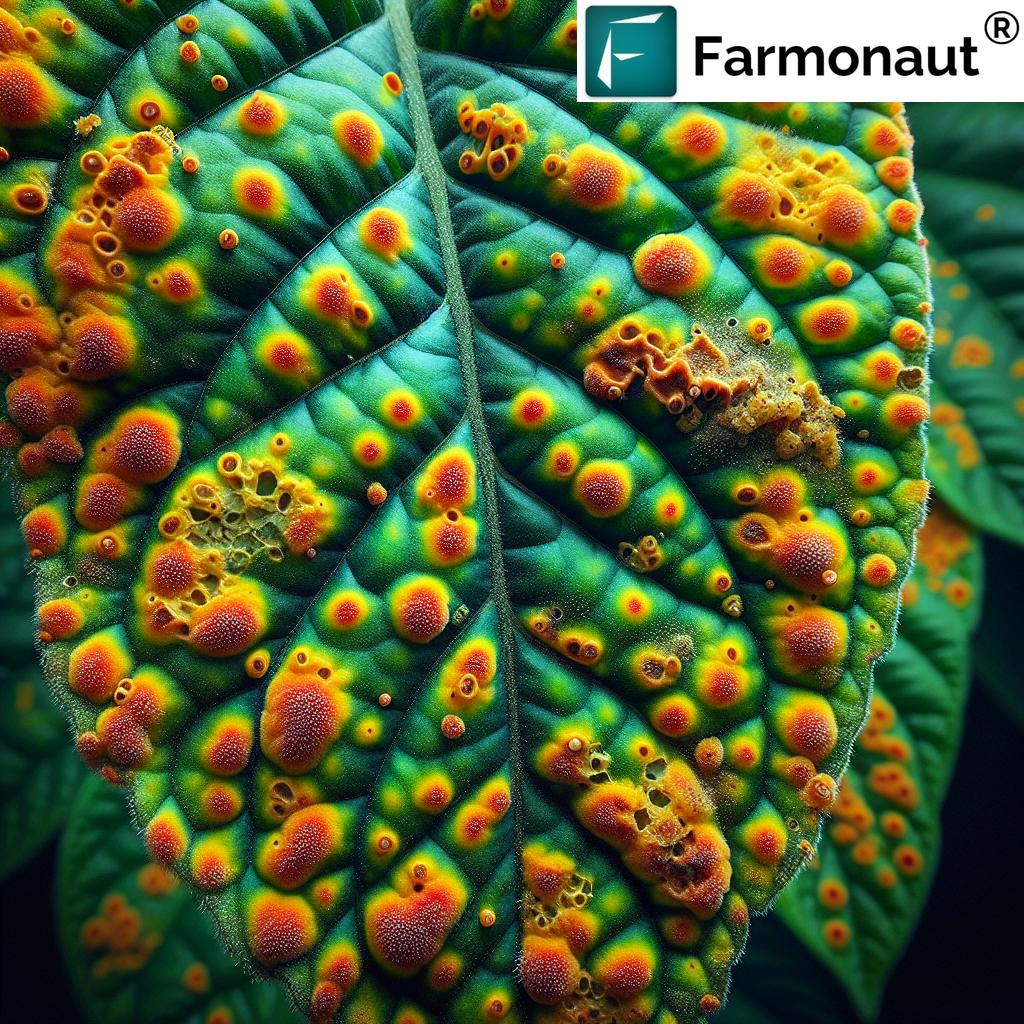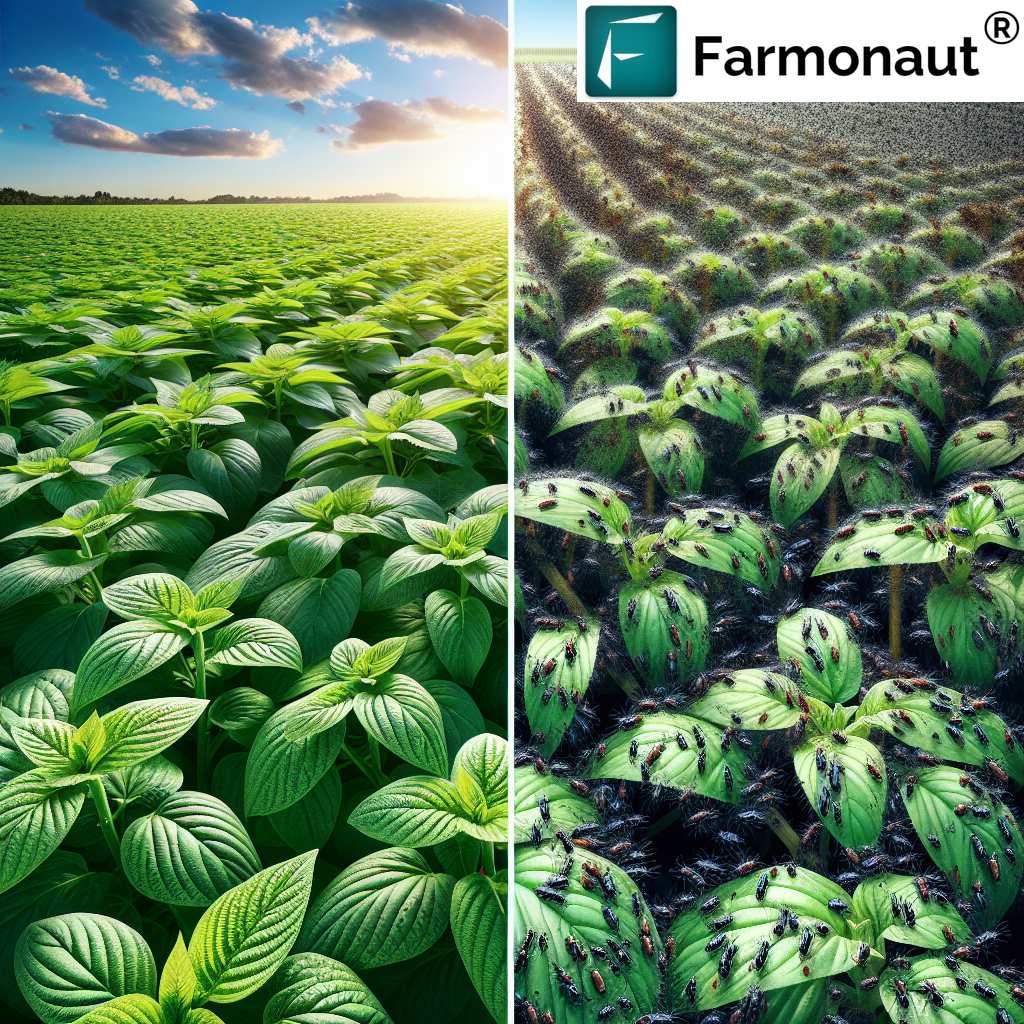Climate That Promotes Powdery Fungus Growth: 7 Controls
- Powdery Mildew: Overview and Importance of Climatic Understanding
- Favorable Climatic Conditions for Powdery Mildew
- Impact of Climate on Powdery Mildew Development
- Geographical Distribution & Climate Influence
- Powdery Mildew Favorability and Control Matrix
- 7 Climate-Based Controls for Powdery Mildew Management
- How Farmonaut Supports Powdery Mildew Management
- Frequently Asked Questions on Powdery Mildew
- Conclusion
“Powdery mildew thrives when humidity exceeds 60% and temperatures range between 15°C and 27°C.”
Powdery Mildew: Overview and Importance of Climatic Understanding
Powdery mildew stands out as one of the most prevalent fungal diseases affecting a vast range of agricultural plants and ornamental species worldwide. From cereals such as wheat and barley to fruits, vegetables, and stunning ornamental plants, its powdery white colonies are a familiar foe for growers and landscape caretakers.
The key to effective powdery mildew management lies in our understanding of climatic factors that create favorable conditions for its growth, infection, and spread. Humidity and powdery mildew are especially connected: high relative humidity is almost always involved in severe outbreaks. Yet, factors such as temperature, leaf wetness, local climate, and light conditions also play crucial roles—either supercharging the disease process or keeping it in check.
In this comprehensive guide, we deep-dive into how environmental conditions—particularly humidity levels and temperatures—affect the development and severity of powdery mildew, and present practical, climate-aligned management strategies that can reduce disease impact by up to 80%.
Favorable Climatic Conditions for Powdery Mildew
Understanding the key environmental and climatic factors is essential to combatting powdery mildew effectively.
Powdery mildew thrives in specific temperature ranges, relative humidity levels, and under certain light and air circulation conditions. Let’s break down why these factors create the favorable conditions for powdery mildew and how each one contributes to the development of this fungal disease.
| Climatic Factor | Estimated Range/Value | Powdery Mildew Risk Level | Suggested Control Measure |
|---|---|---|---|
| Humidity (Relative) | 70% – 95% | High | Increase air circulation, reduce plant density |
| Humidity (Relative) | Below 60% | Low | Monitor; no additional action required |
| Temperature | 15°C – 21°C (59°F – 70°F) | High | Apply fungicides; use resistant varieties |
| Temperature | Above 27°C (80°F) | Low | No urgent action; monitor conditions |
| Leaf Wetness | Short dew periods (not prolonged wetness) | Moderate | Increase air circulation, water early in the day |
| Climate Type | Temperate, moist | High | Monitor closely; integrate cultural controls |
| Climate Type | Arid, hot | Low | Maintain normal practices |
| Light & Air Circulation | Shaded, stagnant air | High | Prune for sunlight and airflow |
Powdery Mildew Temperature Range
- Optimal temperatures for powdery mildew development: 15°C – 21°C (59°F – 70°F).
- Risk is significantly reduced: Above 25°C (77°F), disease progression slows.
Humidity and Powdery Mildew
Relative humidity between 70%–95% is conducive for spore germination and disease progression. At humidity levels above 97%, powdery mildew conidia (asexual spores) germinate rapidly, increasing infection risk. Though free surface water (visible leaf wetness) is not required, brief dew or moist periods can enhance infection.
Light, Shade, and Air Circulation for Plant Disease Prevention
- Powdery mildew is more prevalent: in shaded areas and where air movement is poor, as these conditions help maintain high humidity.
- Increasing air circulation: (via strategic planting and pruning) is a cornerstone practice in ways to control powdery mildew and curb its rapid spread.
Impact of Climate on Powdery Mildew Development
The interplay of climatic factors—primarily temperature, humidity, and air movement—directly influences the epidemiology of powdery mildew in agricultural plants. Let’s look at the direct impact of climate on plant diseases using powdery mildew as the example:
-
Temperature and Humidity Interactions:
- Cool, moist nights followed by warm days set the stage for ideal powdery mildew outbreaks. The combination of high relative humidity overnight (often 80–99%) and daytime warming triggers rapid spore release and infection cycles.
-
Seasonal Variations:
- Spring: Powdery mildew typically emerges early in the growing season as temperatures are moderate and humidity is high.
- Summer: As temperatures rise above 25–27°C (77–80°F) and air becomes drier, disease severity diminishes.
-
Diurnal Fluctuations:
- Variation between day and night temperatures often causes dew formation on leaf surfaces, enhancing short periods of leaf wetness that benefit spore germination.
-
Microclimate Influence:
- Sheltered spots within orchards, fields, greenhouses, or garden beds—where moisture and humidity accumulate—are more likely to foster outbreaks.
“Implementing 7 climate-based controls can reduce powdery mildew incidence by up to 80% in agricultural crops.”
Geographical Distribution and Climate Influence
The prevalence and severity of powdery mildew is closely linked to regional climatic patterns. Whether you manage crops in the Pacific Northwest, the American Midwest, tropical Asia, or Mediterranean orchards, the disease’s geographical distribution is dictated by the present climatic factors for fungal diseases. Let’s explore how different climates and conditions affect the risk:
Temperate Regions (e.g., Pacific Northwest, United States, Europe)
- Mild temperatures, moist air, and frequent dew provide continuous risk for powdery mildew outbreaks, particularly in spring and fall.
- Cereals, fruits, and vegetables in these regions regularly require large-scale farm management solutions to monitor and respond to disease risk patches instantly.
Tropical and Subtropical Climates (Asia, Africa, South America, Southern United States)
- Here, consistently warm temperatures and relative humidity (sometimes exceeding 80–90%) mean that powdery mildew is a significant concern for agricultural plants virtually year-round.
- Greenhouse crops and protected cultivation are particularly susceptible due to poor air circulation and persistent humidity.
Arid and Continental Climates
- Dry air and high daytime temperatures reduce the likelihood of severe outbreaks, but irrigated or densely planted fields may still have isolated cases if microclimates develop.
7 Climate-Based Controls for Powdery Mildew Management
Effective management of powdery mildew involves aligning your strategies with prevailing climatic conditions.
Here are the seven most impactful ways to control powdery mildew by leveraging climate-smart techniques and technologies:
-
Reduce Plant Density to Improve Air Circulation
- High humidity at the leaf surface is reduced when plant spacing is wider and rows are properly aligned. Improved air circulation dries out dew and prevents accumulation of moist pockets that favor infection.
- Applies to all crops, especially cereals, vegetables, and greenhouse-grown species.
-
Tailor Irrigation Practices
- Implementing infrequent, deep irrigation (versus frequent, shallow watering) maintains soil moisture while keeping surface humidity lower.
- Time irrigation for early in the day, which allows foliage to dry before nighttime humidity sets in.
-
Pruning and Canopy Management
- Remove lower or overcrowded leaves and branches that shade others, further reducing humidity and improving sunlight penetration.
- Essential for grapes, apples, and ornamental shrubs—species extremely susceptible to powdery mildew.
-
Balanced Fertilization
- Excessive nitrogen fertilization promotes lush, succulent growth, which is particularly vulnerable to infection—especially during spring and cool seasons.
- Use slow-release fertilizers for sustained, steady growth, and monitor crop health to adjust inputs accordingly.
-
Select Resistant Varieties and Biological Controls
- Choose crop varieties labeled as powdery mildew–resistant or partially resistant whenever possible. While immunity is rare, resistance levels can be high enough to diminish yield losses.
- Support with biological fungicides or natural antagonists to the powdery mildew fungus, tailored to local conditions.
-
Strategic Fungicide Application
- Apply fungicides at vulnerable crop stages (e.g., flag leaf stage in cereals) before anticipated favorable climate events—such as a warm spell after a period of cool, damp weather.
- Always rotate active ingredients to prevent resistance, and time application based on local weather forecasts or real-time data.
-
Leverage Real-time Monitoring and Predictive Technologies
- Use satellite imagery, weather data, and AI-based platforms to monitor microclimates and forecast powdery mildew risk.
- We at Farmonaut provide advanced digital decision support via our satellite-powered platform, empowering users to detect early signs of powdery mildew and align management with on-the-ground conditions.
How Farmonaut Supports Powdery Mildew Management in Changing Climates
At Farmonaut, our mission is to empower farmers, agribusinesses, and institutions to proactively tackle powdery mildew and other crop diseases in today’s climate-impacted world. Leveraging a powerful blend of satellite imagery, AI, and real-time weather data, we help identify microclimates with elevated risk, monitor continuous crop health fluctuations, and optimize resource allocation for disease control.
- Satellite-Based Crop Health Monitoring: Detect subtle canopy color changes, plant biomass, and canopy moisture from space, flagging areas where powdery mildew may gain a foothold.
- AI-based Disease Risk Advisory: Personalized, real-time crop health dashboards predictive of powdery mildew outbreaks—permitting earlier, targeted control interventions.
- Resource & Fleet Management: Deploy field teams, disease scouts, and treatment equipment efficiently using our management suite—saving time and minimizing wastage.
- Blockchain for Traceability: Ensure transparent, disease-free supply chains and build consumer trust for commodities at risk of powdery mildew infection.
- Mobile & API Access: Make “in-the-field, on-the-go” decisions with our Android, iOS, web app, or API—no matter your farm size or location.
Our solutions are designed for everyone—from the smallholder farmer in India or Africa, to large-scale wheat, grape, or vegetable producers in the United States, Europe, and beyond. If you’d like to learn more or start monitoring your own fields:
- Start using the Farmonaut App or Web Dashboard today!
- Develop or integrate powdery mildew risk alerts seamlessly via our API.
Frequently Asked Questions on Powdery Mildew
What makes powdery mildew in agricultural plants such a persistent problem?
Powdery mildew is highly adaptable, with its spores spreading via air and thriving in a vast range of climates and plant species. Its ability to exploit moderate temperatures and high humidity makes it a consistent threat in regions where these conditions frequently align.
Is leaf wetness required for powdery mildew infection?
No. Unlike many other fungal diseases, powdery mildew does not require free surface water for infection. High humidity, however, is crucial for spore germination, meaning that short periods of dew or moist air can significantly enhance disease progression.
How do I know if my crops are entering a high-risk powdery mildew period?
Check your region’s prevailing temperatures and humidity: If nighttime temperatures are between 15–21°C and humidity is above 70%, conditions are favorable for powdery mildew development. Our Farmonaut platform provides real-time climate monitoring and can issue alerts when risk is elevated.
Can powdery mildew fungicides be applied preventatively, or only after symptoms appear?
Best results are achieved when fungicides are applied just before or at the start of favorable conditions for powdery mildew—not after severe symptoms develop. Monitor weather forecasts and crop health closely to time applications optimally.
What are the best practices for air circulation for plant disease prevention?
Reducing plant density, pruning, and orienting rows along prevailing winds are proven ways to increase airflow and reduce humidity at the leaf surface—significantly lowering powdery mildew incidence.
How does Farmonaut’s technology help with powdery mildew control?
Our technology provides:
- Continuous, satellite-driven monitoring of crop health indicators linked to powdery mildew risk.
- Customizable, AI-based advisories for timely cultural and chemical intervention.
- Seamless integration for agribusinesses and developers via API and multi-device access.
Conclusion
Powdery mildew control is no longer just a question of fungicides—understanding and responding to climate is the new foundation for success.
By closely watching temperature and humidity trends, adjusting field practices, choosing resistant varieties, and leveraging advanced monitoring technologies like Farmonaut’s platform, farmers and crop managers can dramatically reduce the prevalence and severity of this pervasive fungal disease.
Whether managing cereals in the United States, grapes in Europe, or vegetables in Asia, aligning your strategies with climate science—and making use of digital decision tools—will keep your plants healthier, your yields higher, and your farming more resilient against shifting disease threats.


















